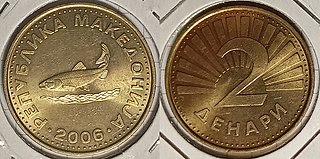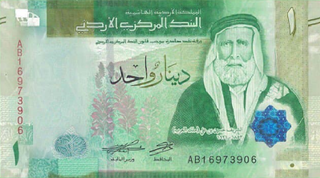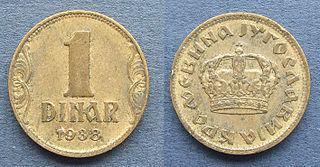The Macedonian denar is the currency of North Macedonia.
Contents
Denar may also refer to:
The Macedonian denar is the currency of North Macedonia.
Denar may also refer to:

The denarius was the standard Roman silver coin from its introduction in the Second Punic War c. 211 BC to the reign of Gordian III, when it was gradually replaced by the antoninianus. It continued to be minted in very small quantities, likely for ceremonial purposes, until and through the Tetrarchy (293–313).

ISO 4217 is a standard published by the International Organization for Standardization (ISO) that defines alpha codes and numeric codes for the representation of currencies and provides information about the relationships between individual currencies and their minor units. This data is published in three tables:

The Polish złoty is the official currency and legal tender of Poland. It is subdivided into 100 grosz (gr). It is the most traded currency in Central and Eastern Europe and ranks 21st most-traded in the foreign exchange market.

The Iraqi dinar is the currency of Iraq. It is issued by the Central Bank of Iraq and is subdivided into 1,000 fils (فلس), although inflation has rendered the fils obsolete since 1990. On 7 February 2023, the exchange rate with the US Dollar was US$1 = 1300 dinars.

The dinar is the name of the principal currency unit in several countries near the Mediterranean Sea, with a more widespread historical use. The English word "dinar" is the transliteration of the Arabic دينار (dīnār), which was borrowed via the Syriac dīnarā, itself from the Latin dēnārius.

The denar is the currency of North Macedonia. Though subdivided into one hundred deni (дени), coins with a denomination of less than one denar have not been in use since 2013.

The Jordanian dinar has been the currency of Jordan since 1950. The dinar is divided into 100 qirsh or 1000 fulus. Fils are effectively obsolete; however, monetary amounts are still written to three decimal places representing fils. It is pegged to the US dollar.

The follis was a type of coin in the Roman and Byzantine traditions.

The dinar is the currency of Bahrain. It is divided into 1000 fils (فلس). The Bahraini dinar is abbreviated د.ب (Arabic) or BD (Latin). It is usually represented with three decimal places denoting the fils.

The dinar is the national currency of Tunisia. It is subdivided into 1000 milim or millimes (ملّيم). The abbreviation DT is often used in Tunisia, although writing "dinar" after the amount is also acceptable ; the abbreviation TD is also mentioned in a few places, but is less frequently used, given the common use of the French language in Tunisia, and the French derivation of DT.
MKD may refer to:
MKN, Mkn or mkn may refer to:

The dinar was the currency of Yugoslavia. It was introduced in 1920 in the Kingdom of Serbs, Croats and Slovenes, which was replaced by the Kingdom of Yugoslavia, and then the Socialist Federal Republic of Yugoslavia. The dinar was subdivided into 100 para.
The modern Islamic gold dinar is a projected bullion gold coin, so far not issued as official currency by any national state. It aims to revive the historical gold dinar, which was a leading coin of early Islam. The currency might consist of minted gold coins (dinars) or of silver coins (dirhams).

The Prague groschen was a groschen-type silver coin that was issued by Wenceslaus II of Bohemia since 1300 in the Kingdom of Bohemia and became very common throughout Medieval Central Europe.
The Kelantanese dinar is a currency issued by the Government of the Malaysian state of Kelantan, which purportedly is in conformance with the concept of the Islamic gold dinar. The Kelantanese dinar is available in the form of coins of several denominations. These coins were first struck in 2006 by Mariwasa Kraftangan of Kuala Kangsar, Perak, a local producer of souvenirs and replicas of objects of art and culture, and launched by the state of Kelantan on 20 September 2006. The Government of Kelantan had suggested that the coins had the status of legal tender, and the state-issued dinar sold out quickly, with many buyers seeing the gold dinar as a better choice than fiat money.
Dinar may refer to:
This is a description of the current and historical currencies of Croatia, or historically used in the region. The currency of Croatia is the euro, in use since 2023.
The Wieluń denar was 14th century silver coin minted in Wieluń. It served as a currency of the Duchy of Wieluń, that existed between 1370 and 1391.